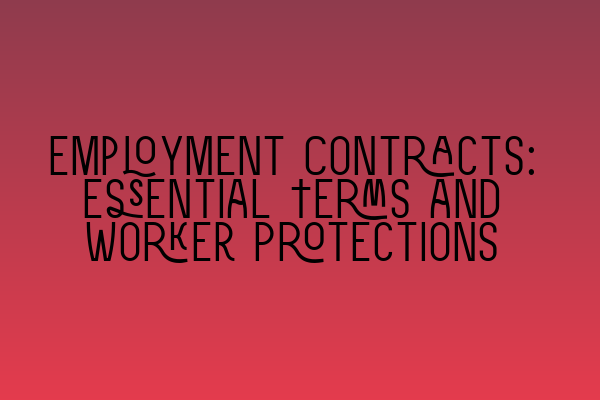Employment Contracts: Essential Terms and Worker Protections
In the realm of employment law, the employment contract is a key document that outlines the rights and responsibilities of both employers and workers. It sets the foundation for the employment relationship and helps ensure that both parties understand their obligations. This blog post will explore the essential terms that should be included in an employment contract and highlight the worker protections that should be afforded to employees.
1. Job Title and Description
One of the fundamental elements of an employment contract is a clear and accurate job title and description. This sets out the role and responsibilities of the employee, providing clarity on the tasks they are expected to perform. It is essential for both parties to have a mutual understanding of the employee’s duties to avoid misunderstandings and potential disputes in the future.
2. Remuneration and Benefits
The contract should clearly state the employee’s salary or hourly rate of pay, as well as any additional benefits they are entitled to, such as healthcare, vacation days, or retirement plans. This ensures transparency and helps avoid any ambiguity regarding the employee’s compensation package.
3. Working Hours and Overtime
Employment contracts should also specify the employee’s regular working hours, including breaks and rest periods. Additionally, the contract should outline the conditions under which overtime may be required and the compensation employees will receive for working beyond their regular hours. Clear guidelines concerning working hours and overtime contribute to a fair and balanced work environment.
4. Probationary Period
Many employment contracts include a probationary period during which the employer evaluates the employee’s suitability for the role. This period allows both parties to assess whether the job is a good fit and provides an opportunity to address any performance issues. It is important to clearly define the length of the probationary period and any specific terms applicable during this time.
5. Notice Period and Termination
The contract should outline the notice periods required by both the employer and the employee in the event of termination of the employment relationship. This ensures that both parties have sufficient time to make alternative arrangements and helps minimize disruption. It is crucial to comply with notice requirements to avoid potential legal or financial consequences.
6. Confidentiality and Non-Disclosure
Employment contracts often include provisions to protect the employer’s confidential information and trade secrets. These clauses prohibit employees from disclosing sensitive information to third parties and may include restrictions on the use of certain information after the termination of the employment. Such provisions help safeguard a company’s intellectual property and maintain competitive advantage.
7. Intellectual Property Rights
In some industries, employees may be involved in creating intellectual property, such as inventions, designs, or artistic works. Employment contracts should clearly address the ownership and use of such intellectual property, ensuring that the employer retains the rights to any creations or innovations developed during the employee’s tenure.
Worker Protections
While employment contracts cover the terms and conditions of employment, it is important to note that workers also enjoy certain legal protections under employment law. These protections are designed to safeguard workers’ rights and ensure fair treatment in the workplace. Some key worker protections include:
1. Minimum Wage
Workers are entitled to receive at least the statutory minimum wage, which varies depending on their age and whether they are an apprentice. Failure to pay the minimum wage is unlawful and can result in penalties for the employer.
2. Equal Pay
Employers must provide equal pay for equal work, regardless of gender. This ensures that men and women receive the same salary or pay rate when performing the same or similar job roles.
3. Health and Safety
Employers have a legal duty to provide a safe and healthy work environment for their employees. This includes assessing and managing potential risks, providing appropriate training and protective equipment, and maintaining workplace health and safety standards.
4. Protection Against Discrimination
Workers are protected against discrimination on the basis of various characteristics, including gender, race, age, disability, and religion. Discrimination can occur at various stages of the employment relationship, from recruitment to termination. Employers must take proactive measures to prevent discrimination and address any discriminatory practices promptly.
In conclusion, employment contracts are essential for establishing clear and transparent terms of employment. They outline the expectations and entitlements of both employers and workers, helping to prevent misunderstandings and disputes. Moreover, the law provides certain worker protections to ensure fair treatment and equal opportunities in the workplace. By understanding and implementing these essential terms and worker protections, employers can create a harmonious and legally compliant work environment.
Related Articles:
– For SQE 1 Practice Exam Questions, visit SQE 1 Practice Exam Questions.
– Looking for SQE 2 Preparation Courses? Check out our courses at SQE 2 Preparation Courses.
– Get ready for the SQE exams with our comprehensive SQE 1 Preparation Courses. Learn more at SQE 1 Preparation Courses.
– Stay updated with the latest SRA SQE Exam Dates by visiting SRA SQE Exam Dates.
